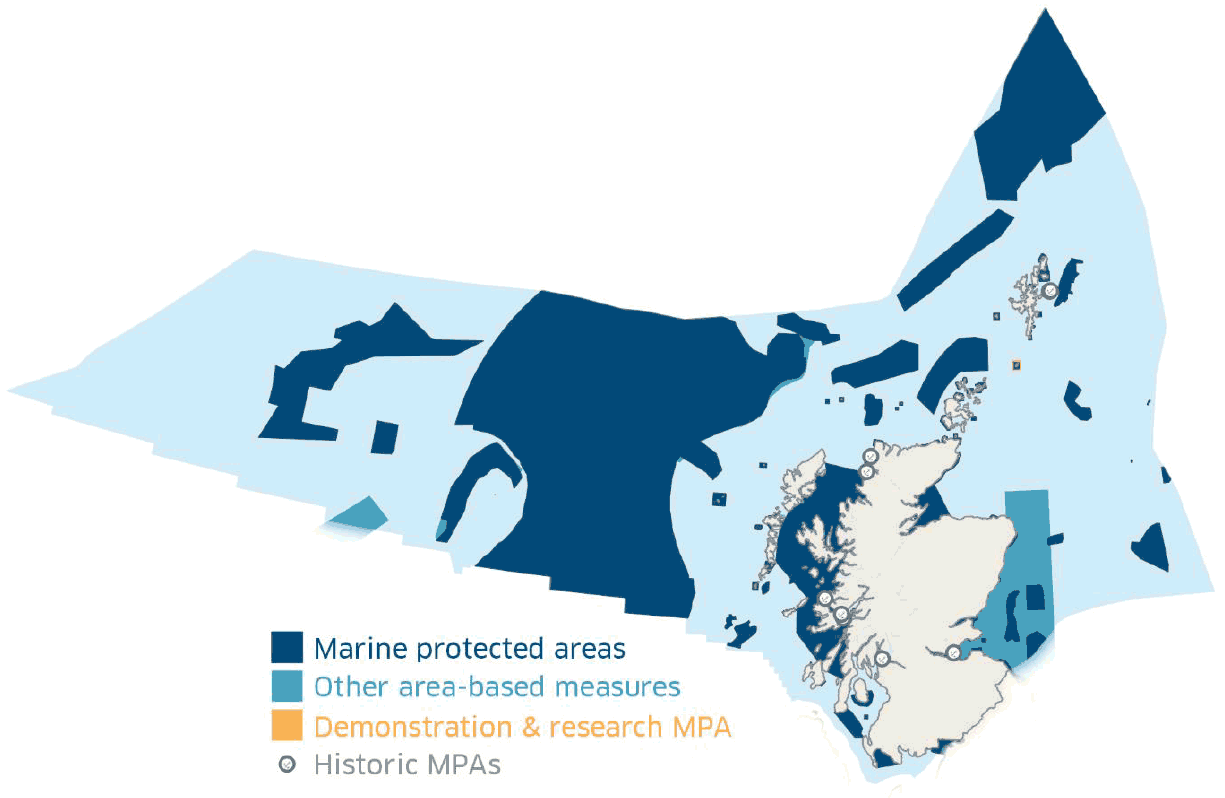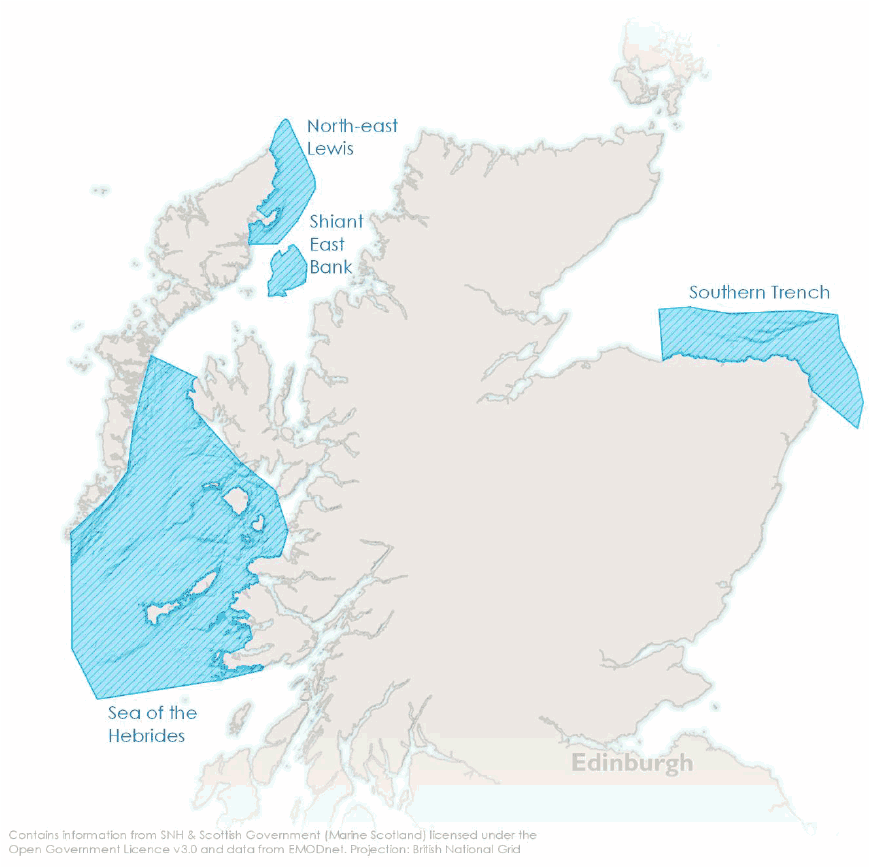Designation of four Marine Protected Areas in Scottish waters: consultation analysis
Summary of the analysis of responses submitted on the designation of the four possible Marine Protected Areas; North-east Lewis, Sea of the Hebrides, Shiant East Bank and Southern Trench.
2. Introduction
2.1. Background to the consultation
2.1.1. Roles and responsibilities
Under the Marine (Scotland) Act 2010 and the Marine and Coastal Access Act 2009, Scottish Ministers are able to designate areas as Marine Protected Areas (MPAs). Scottish Ministers are also obliged to contribute to the UK MPA network. This consultation fulfilled sections 75 of the Marine (Scotland) Act 2010 and 119 of the Marine and Coastal Access Act 2009.
Scottish Natural Heritage (hereafter referred to by its operating name “NatureScot”) is the Statutory Nature Conservation Body (SNCB) for the Scottish inshore waters (within 12 nautical miles). NatureScot provides advice on options for developing site management with the aim of ensuring that the conservation objectives for the protected features are met.
Marine Scotland is a directorate of the Scottish Government, and considers this advice and leads on the development of specific measures and discussions with stakeholders. Marine Scotland is responsible for making recommendations to Scottish Ministers on these measures.
Final decisions on site designations and management rest with Scottish Ministers.
2.1.2. Background
The Scottish Government's vision is for a marine environment that is clean, healthy, safe, productive and biologically diverse; managed to meet the long term needs of nature and people.
The seas around Scotland and the spectacular wildlife they support are one of our best kept secrets, one that only a very few have had the privilege to explore first hand, but upon which we all depend for our quality of life.
Our seas account for 61% of UK waters and remain at the forefront of our food and energy needs, through fishing, aquaculture, oil and gas, and new industries such as renewable energy, as well as recreation activities and eco-tourism.
Scotland’s MPA network is being developed to help safeguard our most important natural and cultural heritage features on the principle of sustainable use. By doing so we are protecting the natural goods and services they provide for current and future generations to enjoy.
The MPA network, as shown in Figure 1, consists of sites designated for nature conservation. In addition to MPAs the network includes areas that: provide nature conservation benefits (called Other Area Based Measures), protect the historic environment (Historic MPAs), and areas for demonstrating or researching marine management. The network currently consists of 231 sites which protect 34% of our seas.

Scottish Ministers have national and international commitments to create a network of MPAs which:
- Contributes to conservation or improvement of the marine environment;
- Represents a range of features present in Scottish waters; and
- Reflects that the conservation of a feature may require the designation of more than one MPA.
2.1.3. The proposals
The four possible MPAs (pMPAs) were originally identified in 2012, however, additional assessment work was needed to improve the evidence base. Since 2012, NatureScot has undertaken habitat modelling, basking shark tagging, Risso’s dolphin photo-identification and seabed surveys to inform the new advice.
As a result of this additional work, NatureScot has provided updated formal advice on the four possible MPAs. NatureScot advised that these sites meet the MPA selection guidelines and that they are necessary to progress towards completion of the Scottish MPA network. The locations of the four sites as consulted on are shown in Figure 2 and Table 1 provides an overview of the four sites and protected features.
| Site Name | Size (km2) | Proposed Protected Features | |
|---|---|---|---|
| Biodiversity | Geodiversity | ||
| North-east Lewis | 907 | Risso’s dolphins, sandeels | Marine geomorphology of the Scottish shelf bed, Quaternary of Scotland |
| Sea of the Hebrides | 10,039 | Basking sharks, minke whales, fronts | Marine geomorphology of the Scottish shelf seabed |
| Shiant East Bank | 308 | Circalittoral sands and mixed sediment communities, northern sea fan and sponge communities, shelf banks and mounds | Quaternary of Scotland |
| Southern Trench | 2,536 | Burrowed mud, minke whales, fronts, shelf deeps | Quaternary of Scotland, submarine mass movement |

2.2. Format of the consultation
2.2.1. Pre-consultation workshop
The Scottish Government hosted a pre-consultation workshop on 13 March 2019 in Edinburgh. Thirty-one stakeholders attended the workshop representing 18 organisations from sectors including fisheries, environment, tourism, local authority and other government departments. Attendees were provided with an overview of the proposals and an opportunity to view the draft consultation papers. A full report of the workshop is available.
2.2.2. Consultation questions
The Scottish Government held a consultation on the proposals from 07 June 2019 to 30 August 2019. Views were invited on five questions in relation to the pMPAs. These questions were:
1. Do you support the designation of these possible Marine Protected Areas?
2. Do you agree that the scientific evidence presented justifies the case for the designation of each site?
3. Do you have any comments on the Conservation and Management Advice for each site?
4. Do you have any comments on the Business and Regulatory Impact Assessments for each site?
5. Do you have any comments on the Sustainability Appraisal, including the Environmental Report and the Socio-Economic Impact Assessment?
In order to help respondents answer these questions, supporting information was available. For each site, the following documents were available:
- Data confidence assessment of the scientific evidence;
- MPA Selection Guidelines assessment;
- Conservation and management advice (CMA); and
- Business and Regulatory Impact Assessments (BRIAs).
In addition, the following documents provided evidence on the four sites together:
- A Strategic Environmental Assessment (SEA);
- A Socio-Economic Impact Assessment (SEIA); and
- A Sustainability Appraisal, combining environmental, social and economic effects.
2.2.3. Consultation events
During the consultation, 14 events were held around Scotland to provide information to local communities who may be interested in the proposals. Details of the events are shown in Table 2. NatureScot and Scottish Government staff were available to answer questions and provide information about the proposals.
| Banff, Aberdeenshire | 24 June 2019 | Fife Lodge Hotel |
|---|---|---|
| Fraserburgh, Aberdeenshire | 25 June 2019 | The Museum of Scottish Lighthouses |
| Peterhead, Aberdeenshire | 26 June 2019 | Palace Hotel |
| Elgin, Moray | 27 June 2019 | Elgin Town Hall |
| Tobermory, Mull | 16 July 2019 | Aros Hall |
| Arinagour, Coll | 17 July 2019 | An Cridhe |
| Crossapol, Tiree | 18 July 2019 | An Talla |
| Castlebay, Barra | 16 July 2019 | Lews Castle College |
| Lochboisdale, South Uist | 17 July 2019 | Southend Community Hall |
| Lochmaddy, North Uist | 18 July 2019 | Lochmaddy Community Hall |
| Leverburgh, Harris | 23 July 2019 | Leverburgh Village Hall |
| Stornoway, Lewis | 25 July 2019 | Bayhead Bridge Centre |
| Portree, Skye | 30 July 2019 | Skye Camanachd Social Club |
| Mallaig, Highland | 31 July 2019 | Mallaig and Morar Community Centre |
2.3. Respondents to the consultation
In total, 222 official consultation responses were received, either through email or through the Citizen Space consultation portal.
Two responses were received after the consultation closing date on 30 August 2019. These responses were considered valid and have been included in the analysis below.
A breakdown of the respondent categories can be found in section 4.1. and a full list of organisations which responded is in Annex B.
2.4. Format of this consultation report
This consultation report comprises of two parts; a quantitative and qualitative analysis of the consultation responses (section 4), and a discussion of the main themes contained within responses including the Scottish Government response (section 5).
The quantitative analysis work was commissioned by Scottish Government to provide clear information about the themes contained within the responses and the expectations of the Scottish people about these proposals.
The discussion section allows Scottish Government and NatureScot to provide background and additional information on points requiring clarity, explain changes made because of responses, and explain areas which are outwith the scope of this consultation. The discussion section does not include consideration of every comment made however the most relevant themes mentioned by multiple responses are included.
2.4.1. Ensuring data protection compliance
To provide a comprehensive picture of the consultation undertaken, some quotes have been provided from responses received.
To ensure compliance with data protection, respondents were asked by the Scottish Government if their responses could be published online. The appropriate data redaction has been implemented dependent upon the respondents answer to this question.
Where respondents have stated that ‘Publish response only (without name)’, quotations have been provided with the appropriate data redacted. To provide context to the response, the respondent category that the respondent was identified as is provided.
No quotations have been provided from respondents who provided an answer “Do not publish response”. These responses were still analysed and contributed towards the consultation analysis.
Contact
Email: marine_conservation@gov.scot
There is a problem
Thanks for your feedback